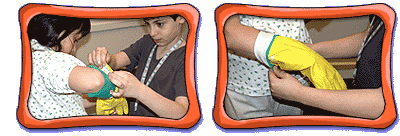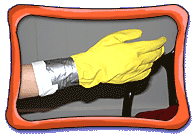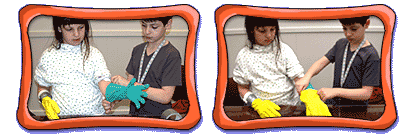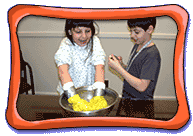Rubber Blubber Gloves
Instructions
In this experiment, you'll create two gloves — one that contains a layer of shortening (blubber) inside, and one that doesn't. By putting both glove-covered hands in a bucket of freezing c-c-c-cold water, you'll find out if the blubber-covered hand feels warmer than the hand without the fat layer.
What You'll Need

- 2 small, thick rubber gloves (that slide on and off your hands comfortably)
- 2 large, thick rubber gloves (that you can comfortably put on and take off over the other gloves) (NOTE: If thick rubber gloves aren't available, you can use thick plastic freezer bags.)
- shortening (such as Crisco™)
- rubber spatula
- duct tape
- bucket (wide enough so you can put both hands in at once)
- cold water
- ice cubes (at least 12)
What To Do

Before you start, warm your hands up by rubbing them together.
Making the Gloves

Put a SMALL rubber glove on your hand. Have your partner smear a thick layer of shortening on it with the rubber spatula. Smooth out the shortening as if you were icing a cake until there's an even layer on the glove.


Have your partner help you pull the LARGE rubber glove over the shortening-covered glove. Make a cuff at the wrist, folding the bottoms of both gloves upward.


Wrap duct tape around the cuff to seal in the shortening layer.


Put the other small rubber glove on your other hand. Then pull the other large rubber glove over it. (No shortening between the gloves this time.) Make a cuff, and use the duct tape to seal the bottom of the two gloves.

Testing the Gloves

Fill the bucket with cold water, and add lots of ice.

Dip both hands in the bucket at the same time, and hold them there for at least 10 seconds. Do you notice a difference?


Take off both gloves, and dry them off. Have your partner repeat the experiment. (Make sure your partner's hands are warm before putting on the gloves.)
TIP: If you remove the rubber gloves carefully, you'll be able to try this experiment again and again.

Think About Your Results
Why did we ask you to create two kinds of gloves — one containing fat (Crisco™) and one with nothing inside? Any good experiment has a variable and a control. The variable is the condition you are changing. The control is the version of the experiment without this condition. With a control, you can compare and measure any differences between the results. These comparisons allow you to make hypotheses, or draw meaningful conclusions.
You wanted to investigate this question: How does a layer of blubber insulate sea animals against cold ocean waters? So, you created two kinds of gloves — one with a layer of fat (the variable) and one without (the control).
How were the two experimental conditions the same? For example, in both conditions you used the same kind of gloves, the same people, warmed your hands first both times, and put your gloved hands into the same bucket of freezing water.
Image Credits:
All photos courtesy of AMNH.




 Biodiversity
Biodiversity
 Brain
Brain
 Genetics
Genetics
 Marine BiOLogy
Marine BiOLogy
 MicrobiOLogy
MicrobiOLogy
 PaleontOLogy
PaleontOLogy
 ZoOLogy
ZoOLogy
 AnthropOLogy
AnthropOLogy
 ArchaeOLogy
ArchaeOLogy
 Astronomy
Astronomy
 Climate Change
Climate Change
 Earth
Earth
 Physics
Physics
 Water
Water
